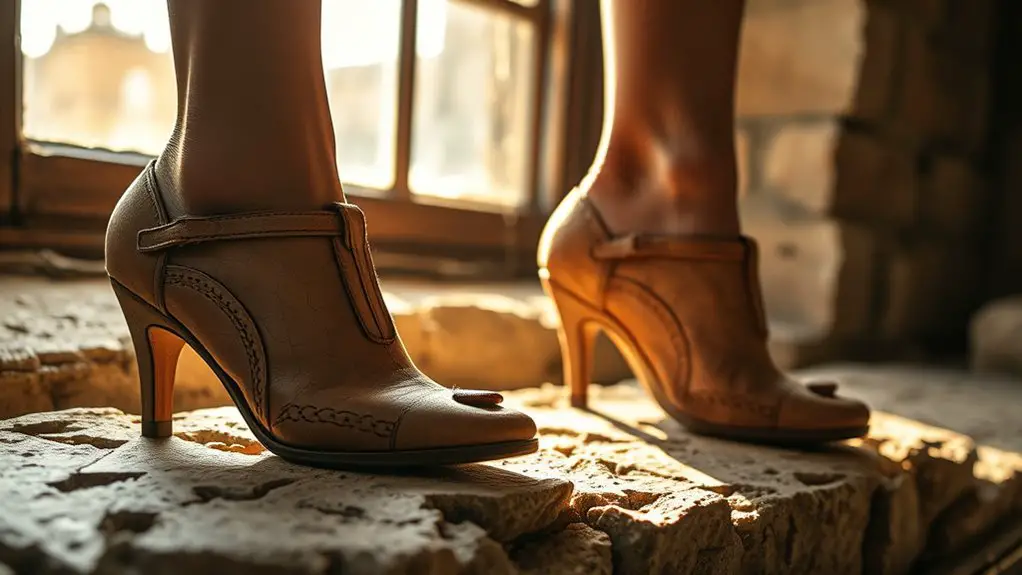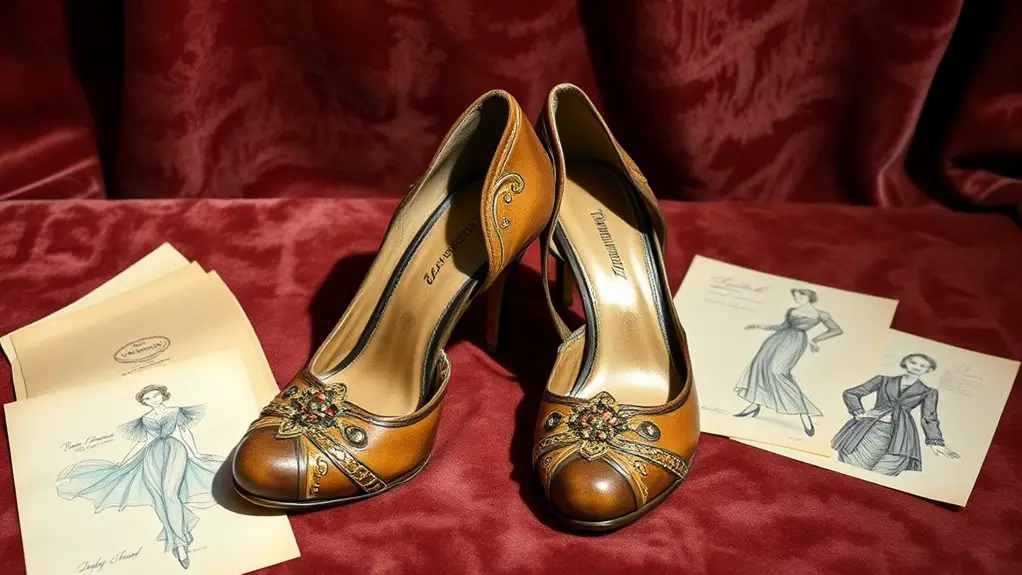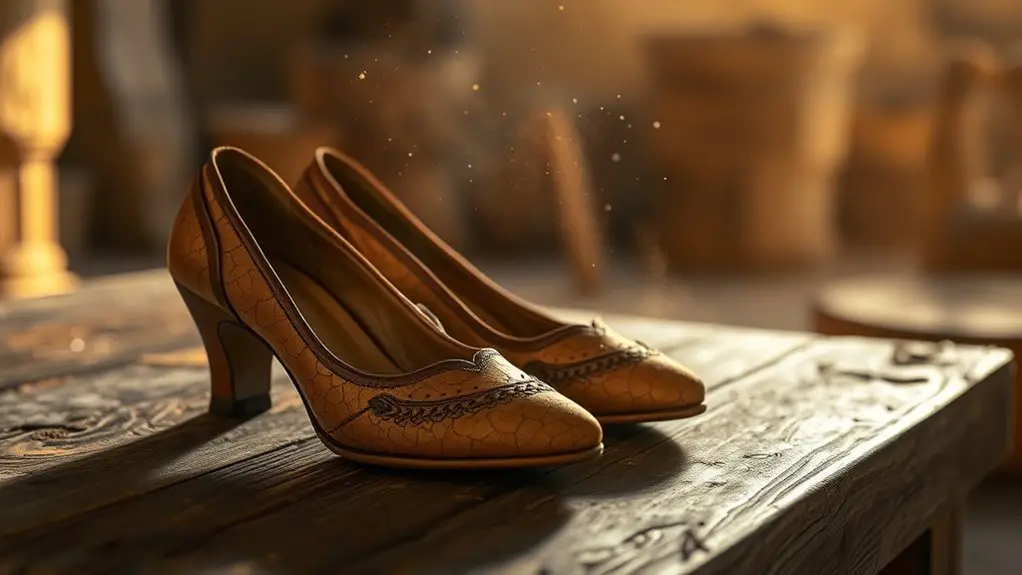The oldest known pair of high heels dates back to 12th century Persia, reflecting sophisticated craftsmanship and cultural depth. These heels weren’t just for show; they served practical purposes, enhancing stability while riding. In ancient societies, footwear indicated status and identity, with design and materials signaling wealth. The evolution from these heels to modern designs showcases changing perceptions of fashion and femininity. There’s much more to explore about how high heels have shaped and reflected societal values throughout history.
The Discovery of the Ancient Heels

The discovery of the ancient heels marked a significant moment in the history of fashion and footwear. Unearthed through meticulous archaeological techniques, these artifacts reveal more than just a design; they showcase the sophisticated ancient craftsmanship that catered to both aesthetic and functional needs. As you explore their construction, you’ll notice the intricate details that hint at a deeper cultural significance, indicating that high heels were not merely a fashion statement but a symbol of status or identity.
The careful excavation processes employed allowed researchers to preserve these delicate remnants, offering insights into the materials and methods used in their creation. By analyzing wear patterns and the context in which these heels were found, you can appreciate how they reflect the societal norms of their time. This discovery transforms our understanding of footwear, pushing you to reconsider the origins and evolution of styles you see today.
Historical Context of High Heels
High heels have a fascinating history that traces back to their origins in 10th century Persia, where they served a practical purpose for horseback riding. Over time, their cultural significance evolved, symbolizing status and power in various societies, particularly in Europe during the Renaissance. As you explore this evolution, consider how high heels reflect changing societal norms and the complex relationship between fashion and identity.
Origins of High Heels
While many associate high heels with modern fashion, their origins trace back to the 10th century, when Persian cavalrymen wore them to secure their feet in stirrups. This innovative approach to ancient footwear highlighted the practical need for stability and control during battle. As high heels evolved, they changed from functional designs to symbols of status and power. By the 16th century, European aristocrats adopted various heel designs, emphasizing height and elegance. These changes marked a shift in perception, where high heels became associated with femininity and allure. Understanding these origins reveals how high heels began as utilitarian items, gradually transforming into fashion statements that reflect societal norms and values throughout history.
Cultural Significance Over Time
Although many view high heels as a modern fashion staple, their cultural significance has evolved dramatically over centuries, reflecting changing societal values and norms. Initially, high heels symbolized status and power, often worn by aristocrats to signify wealth and influence. As time passed, their meaning shifted; they became associated with femininity and beauty, emphasizing the cultural evolution surrounding gender roles. In the 20th century, high heels emerged as a social symbolism of empowerment, allowing women to assert their presence in a male-dominated society. Today, high heels continue to evoke a complex interplay between elegance and discomfort, reflecting ongoing debates about beauty standards and self-expression. Understanding this evolution offers insight into how fashion both shapes and reflects our cultural landscape.
Construction Techniques of the 12th Century

As medieval society shifted into the 12th century, innovations in construction techniques reflected both the era’s burgeoning architectural ambitions and practical needs. You’d notice that medieval craftsmanship was becoming increasingly sophisticated, as builders employed techniques such as ribbed vaulting and flying buttresses to enhance structural integrity and aesthetic appeal. These advancements not only allowed for taller structures but also facilitated the creation of vast interior spaces, influencing the design of cathedrals and castles.
Architectural influences from earlier Roman and Byzantine styles were evident in this period. You can see how artisans integrated local materials, emphasizing regional characteristics while adhering to these broader influences. The emphasis on light in Gothic architecture led to the use of stained glass windows, which combined artistry with functionality. Overall, the construction techniques of the 12th century laid the groundwork for future architectural developments, reflecting a blend of innovation and tradition that defined the era.
Cultural Significance of Footwear in Ancient Persia
In ancient Persia, footwear wasn’t just a practical necessity; it represented a person’s status and identity within society. You’d find that the design, material, and embellishments of shoes often indicated one’s wealth and social standing, creating a visual hierarchy. This cultural significance reflects how deeply intertwined fashion and identity were in Persian life, influencing everything from daily attire to ceremonial occasions.
Footwear in Persian Society
Footwear in ancient Persian society wasn’t just a practical necessity; it reflected social status, cultural identity, and artistic expression. Persian footwear showcased the incredible skill of ancient craftsmanship, often highlighting intricate designs that conveyed regional influences and personal taste. Each pair of shoes, whether sandals or boots, served as a canvas for artisans to display their expertise, using materials like leather, silk, and precious metals. The attention to detail in stitching and embellishments provided insight into the wearer’s background, showcasing not only their wealth but also their connection to Persian heritage. In this way, footwear transcended mere functionality, becoming an essential component of identity and a reflection of the rich cultural tapestry of ancient Persia.
Symbol of Status and Identity
The intricate designs of ancient Persian footwear served not just as functional items but as powerful symbols of status and identity. When you look at these shoes, you’re not just seeing craftsmanship; you’re witnessing a form of identity expression. Footwear was often adorned with elaborate motifs, indicating the wearer’s social rank and wealth. For the elite, specific styles and materials became status symbols, setting them apart from commoners. In a society where hierarchy was paramount, the shoes you wore could communicate messages about your place within the social structure. Consequently, each pair of high heels or intricately designed sandals reflected not only personal taste but also the broader cultural values of prestige and identity in ancient Persia.
Fashion Trends and Their Evolution Over Time

As fashion constantly evolves, it reflects not just personal expression but also cultural shifts and societal values. You can trace the trajectory of style from the opulence of the Renaissance to the minimalist aesthetics of modernity. Each era showcases fashion innovation, where designers push boundaries to create pieces that resonate with the zeitgeist. For instance, the flamboyant silhouettes of the 18th century contrast sharply with today’s sleek lines, yet both embody timeless elegance in their own right.
Moreover, trends often cycle back, showcasing the innate human desire for nostalgia. You might notice how vintage styles resurface, reinterpreted to suit contemporary tastes, blending the past with the present. This evolution isn’t merely aesthetic; it mirrors changing gender roles, economic conditions, and technological advancements. In understanding these dynamics, you gain insight into how fashion serves as a powerful medium for identity and societal commentary throughout history.
Comparison With Modern High Heels
While the oldest pair of high heels reflects the artistry and craftsmanship of its time, modern high heels have transformed into a multifaceted symbol of both fashion and functionality. Today, you’ll find high heels crafted from modern materials like synthetic leather and lightweight plastics, offering improved comfort and durability. This design evolution has led to innovations such as ergonomic footbeds and shock-absorbing soles, making heels more wearable than ever.
Moreover, contemporary styles range from stilettos to block heels, catering to diverse tastes and occasions. Unlike their ancient counterparts, which emphasized height and posture, modern high heels balance aesthetics with practicality, allowing you to navigate daily life with greater ease. The integration of technology in design has also enhanced the overall experience, ensuring high heels serve not just as a fashion statement but also as a reflection of evolving societal norms surrounding beauty and comfort.
Implications for Understanding Fashion History
Understanding fashion history requires examining artifacts like the oldest pair of high heels, which not only highlights the evolution of style but also reveals deeper societal values and norms of their respective eras. When you analyze these high heels, you see how fashion evolution reflects changes in social status, gender roles, and economic factors. For instance, these heels were likely worn by nobility, symbolizing wealth and power.
Their design and construction offer insights into the materials and craftsmanship of the time, showcasing technological advancements and the importance placed on aesthetics. Additionally, the historical impact of high heels extends beyond mere footwear—they signify a shift in how society perceives femininity and allure. By studying these artifacts, you can better understand the cultural narratives woven through fashion, revealing not just trends, but the very fabric of human experience across generations.
Frequently Asked Questions
What Materials Were Used to Create the Ancient High Heels?
Imagine the delicate artistry of ancient craftsmanship, where leather, wood, and metal intertwined, each material’s significance reflecting status and elegance. These high heels, meticulously crafted, reveal a rich tapestry of culture and fashion from a bygone era.
How Were the Ancient Heels Maintained or Repaired?
To maintain ancient heels, you’d likely rely on repair techniques such as stitching or re-soling, complemented by maintenance practices like cleaning with oils. These methods would help preserve their structural integrity and prolong their lifespan effectively.
Who Wore the Oldest High Heels in Ancient Persia?
Like a regal peacock flaunting its feathers, Persian royalty donned high heels as fashion symbolism, showcasing status and sophistication. These elevated shoes were primarily worn by aristocratic women, signifying both elegance and power in ancient Persia.
What Other Footwear Styles Existed Alongside High Heels in the 12TH Century?
In the 12th century, alongside high heels, you’d find medieval footwear like pointed shoes and ankle boots. Historical trends favored practicality, often reflecting social status, while designs evolved with materials and craftsmanship of the time.
Are There Any Myths Associated With Ancient High Heels?
There’re various myths about ancient high heels, often linked to their mythical origins. These tales emphasize their cultural significance, suggesting they symbolized power, status, or even divine favor, shaping perceptions of footwear throughout history.



